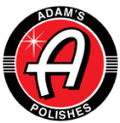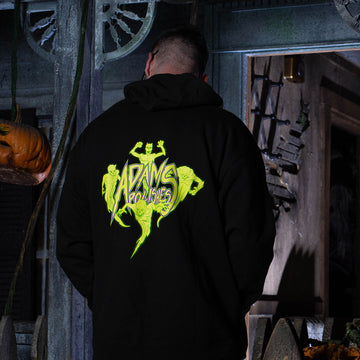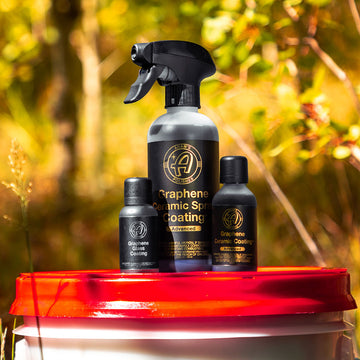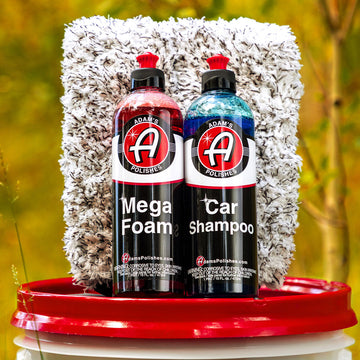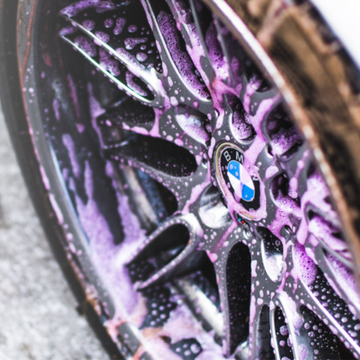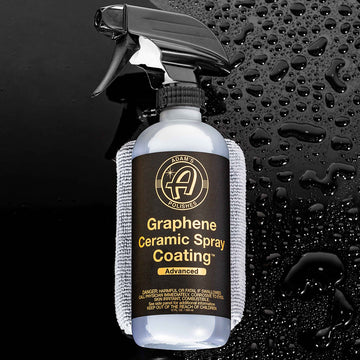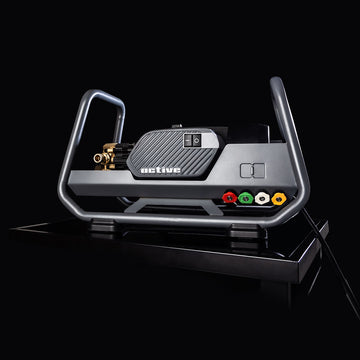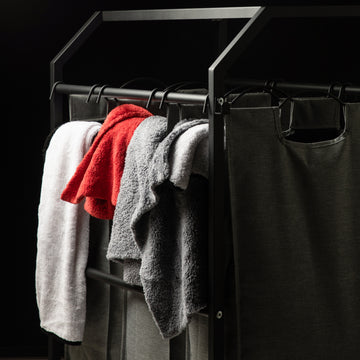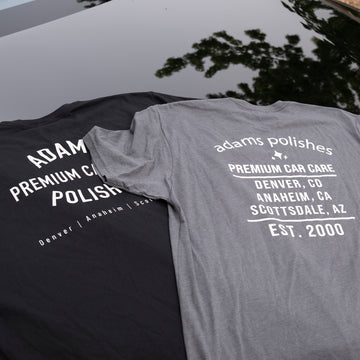Today's modern vehicle interiors feature an increasingly wide variety of surfaces and materials. In sports cars, luxury vehicles, and upgraded trim packages, manufacturers are more commonly using a suede-like material referred to as Alcantara or micro-suede for various interior surfaces - seats, door panel inserts, dashboards, steering wheels, and even headliners. Alcantara has a premium feel and appearance, but requires more care than something like leather (covered in a previous blog) or cloth. Carpet and upholstery surfaces can sometimes be tricky to remove dirt, winter salt buildup, stains, and other debris, so they also need specific methods and products to clean them. In this blog, we explain how to clean, protect, and maintain Alcantara, carpet, and upholstered surfaces on the interior of your vehicle, to keep them from possible damage and looking their best for years to come.
Introduction
Cleaning Suede & Alcantara
To help in understanding how to clean Alcantara or suede surfaces, let’s first answer the question “What is Alcantara?” Alcantara is a fully synthetic microfiber material composed of polyester and polyurethane. It has a look and feel very similar to suede, but has improved stain resistance, lighter weight, lower cost, and more durability when compared to real suede. Because of these characteristics, it has obvious benefits for use in automotive interiors. Alcantara has a smooth feel but helps keep you planted in the seat, and it provides a more firm grip on steering wheels and shift knobs. It has better cooling capability than leather, and handles moisture and sweat better than cloth; however, it is still susceptible to wear from neglect and too much exposure to moisture.
Regular Cleaning and Maintenance
Preventing issues before they occur is always the best option when it comes to caring for Alcantara and micro-suede, and this can usually be done with simple and easy maintenance. As micro-suede is sat on or handled, it begins to look matted and worn. Depending on whether your vehicle is driven daily, a track toy, or weekend cruiser that only sees use for fun, the rate that you need to perform regular cleaning will change. The amount of driving time is the main factor in how often you should clean the Alcantara surfaces. The easiest step to prevent premature wear and keep the synthetic suede materials looking their best is to gently brush the surfaces regularly. Adam’s Cockpit Brush and Mini Cockpit Brush have durable but soft nylon bristles and are very effective at cleaning suede, vinyl, and leather surfaces.
The most frequent method you will use to clean Alcantara is to use the dry Cockpit Brush with no chemical cleaner. Brushing the fibers gently can prevent them from becoming permanently matted down, and it will also aid in removing dust, crumbs, or small debris that may have settled on the surface or into the creases of a seat. Then make sure to use a vacuum like the Adam’s Barrel Vacuum to suck out all of the loosened debris. A low-pile microfiber towel, like our Edgeless Utility Towel, folded in your hand will work as a substitute for a brush, but the Cockpit Brush will provide better, more consistent cleaning capability. You must make sure not to brush or scrub the material with too much pressure or effort - using too much force or bristles that are too aggressive can cause the Alcantara to ball, or roll up, into small blobs, known as pilling. If this does occur, we’ll explain different methods on how to deal with pilling later in this writeup.
We recommend gently brushing out the Alcantara and micro-suede surfaces once a week for most average-use vehicles. For vehicles that see large amounts of driving, brush these surfaces more frequently, i.e. twice a week. Also, make sure to brush high-traffic areas like the driver seat and any suede on the steering wheel, shift knob, or armrests more often than you would other areas of the interior. Recline seat backs so that you can get into all of the nooks and crannies - Adam’s Large or Small Interior Brush can be used to get into cracks and crevices where it might be more difficult to reach with the Cockpit Brush. For a track vehicle, Alcantara surfaces will most likely get more dirt, dust, and sweat buildup, so we’ll cover more moderate cleaning below.
Moderate Cleaning of Steering Wheels, Shifters, and Seats
Alcantara looks and feels great on steering wheels, shifter knobs, and seats, and provides the driver with a nice, non-slip grip; however, oils and sweat from your hands can wear down these areas faster than the door panels and other interior areas wrapped in micro-suede. Oils and sweat that soak into the suede will attract additional dust and lead to a soiled, discolored, and matted surface. As mentioned earlier, regular brushing of the steering wheel, shift knob, and driver seat more frequently than other micro-suede areas will help prevent or slow the material from matting as quickly - gently brush these surfaces out as often as they appear to be getting flat. Once oils begin to soak into the surface, you will usually need to introduce water or a chemical to remove them, but you must be careful not to make the Alcantara or micro-suede too wet, since this can permanently damage the material. Try an Edgeless Utility Towel dampened with water first, but if staining or discoloration remains, you will then need to move to a chemical cleaner. Two chemicals that we offer that are safe for use on Alcantara and micro-suede are Carpet & Upholstery Cleaner and Total Interior Cleaner. Lightly mist a few sprays of one of the chemicals directly into an Edgeless Utility Towel or Interior Microfiber Towel, and then gently blot and wipe the towel into the material to break up skin oils and loosen dirt that will not come out from brushing alone. Then use a second dry towel to absorb any excess moisture from the cleaner.
The process for addressing moderate soiling on these surfaces is as follows:
-
Brush and vacuum the surfaces to remove any dust and loose debris.
-
Try cleaning with an Edgeless Utility Towel dampened with water.
-
If stains remain, spray a very small amount (2 or 3 sprays) of Carpet & Upholstery Cleaner or Total Interior Cleaner onto a clean Edgeless Utility Towel or Interior Microfiber Towel.
-
Gently blot the surface, then wipe. On steering wheels, typically the most serious contamination will be from the 9 o'clock to 3 o'clock hand positions of the wheel.
-
Add additional cleaner to the towel as needed and repeat until the soiling is removed. Do not get the surface overly saturated with liquid.
-
Blot up any excess moisture with a separate clean, dry Edgeless Utility or Interior Microfiber Towel.
How to Remove Pilling
When it becomes too worn, Alcantara (and other upholstery) can sometimes roll up into little fuzzies, or blobs, referred to as pilling. Small fragments of the fabric material are pulled from the surface and then roll up and form into small balls above the surface. De-pilling Alcantara or micro-suede can be accomplished with a few different techniques, some of which have more potential for additional damage than others. The first and safest method would be to take a new, dry Adam’s Deep Clean Eraser and carefully brush the area with the eraser. The Deep Clean Eraser can remove small amounts of light pilling. The next option would be to use sandpaper to very carefully sand off the small blobs from the surface. Use 1500 grit or finer (higher) sandpaper, and be very cautious - too much pressure and you could damage the Alcantara even further. The next option, with the biggest possibility of damage, would be to use a razor blade to very carefully “shave” the fuzziness from the surface. Using a razor blade requires extreme caution to not cut yourself or slice the fabric, which could then require replacement of a panel, seat cover, etc.
Cleaning Carpet & Upholstery
Another area of the interior that sees constant traffic is the carpet. Carpet and carpeted floor mats can be some of the most soiled areas in most vehicles - leaves, mud, snow, salt, ash, sand, grass, animal fur, and dirt - the list goes on. Some of these things are much easier to clean up than others, needing just a quick vacuum. Other contamination will require more effort to remove, needing more specialized tools and chemicals to help loosen debris or remove stains and discoloration. Next, we’ll cover the various products that we offer and the techniques to use them properly.
Restoring Carpet
After vacuuming to remove heavy debris, we have a few options when it comes to deep cleaning carpet to restore it to its original appearance. In some cases, our Carpet & Upholstery Cleaner sprayed into the carpet or floor mat, then gently scrubbed with the Cockpit Brush and wiped with an Edgeless Utility Towel will be enough to remove discoloration from light dirt or dust buildup. In other situations, you may need much more heavy duty cleaning. Adam’s Multi-Use Foaming Cleaner is an excellent choice for spot treatment of difficult, relatively recent stains. The foaming formula penetrates down into the carpet fibers, and when combined with a cordless drill and the Carpet Drill Brush, it can pull out significant stains without much effort. Make sure to wipe the area afterward with a dry Edgeless Utility Towel, allow it to air dry for several hours, and then vacuum up any extra dried up cleaner and dirt particles. Wiping in one direction with the Edgeless Utility Towel will raise the nap of the carpet fibers and allow it to dry more quickly.
One aerosol can of Multi-Use Foaming Cleaner can be used up rather quickly - it will usually cover about one full driver or passenger front floor area, so it’s more designed for spot cleaning of smaller areas at a time. For cleaning of larger areas or the entire carpeting in a vehicle, Carpet & Upholstery Cleaner, All Purpose Interior Cleaning Gel, or Total Interior Cleaner are more suitable options. All three can be used with the Cockpit Brush, Edgeless Utility Towel, and the Carpet Drill Brush:
-
Carpet & Upholstery Cleaner is a low-sudsing formula that works very effectively at removing stains and discoloration, but is gentle enough to not damage the texture or color of the surface.
-
All Purpose Interior Cleaning Gel is a thick liquid with high-foaming capability when used with the Carpet Drill Brush or if using the 6oz foaming pump spray bottle option.
-
Total Interior Cleaner will create foaming action on carpets, while also providing a cross-polymer protection (similar to our exterior Slick & Slide spray) while it cleans.
If you have an air compressor, we offer one more accessory tool that is outstanding for removing heavy buildup from carpets. The Adam’s Interior Cleaning Gun uses compressed air along with a liquid canister to blast a spiral stream of compressed air, or by flipping the toggle switch, compressed air mixed with water or a diluted chemical solution into carpet. The Interior Cleaning Gun pushes and forces dirt, grime, and stains up out of the material, to then be wiped up with a microfiber towel or vacuumed with a wet-dry vacuum. The Interior Cleaning Gun is perfect for cleaning down into tight seams and edges of carpet by plastic kick panels, in and around seat rails, and other areas where you may not be able to easily reach scrubbing with your fingers and a towel or Cockpit Brush. The nylon bristles at the end of the barrel allow for agitation of the material and chemical, but also provide safer cleaning around delicate plastic areas that may scratch more easily from the aluminum barrel. When using the Interior Cleaning Gun with a cleaning chemical like Carpet & Upholstery Cleaner, fill the canister mostly with water, then pour in 3-4 ounces of cleaner and lightly mix the two together.
Cleaning Upholstery
Cleaning upholstered surfaces like cloth seats, arm rests, and other areas of the interior is usually straightforward, since cloth seats will usually have a thick and durable cloth material covering them. Sometimes thinner fabric and certain areas will require special care, similar to cleaning Alcantara, which we covered earlier in this write-up. We’ll cover these different scenarios below.
Cloth Seats and Armrests
When it comes to stained or dirty cloth seats and armrests, the type of fabric material will determine the best way to clean them. On plush seats or arm rests with thick upholstery, generously spraying them with Carpet & Upholstery Cleaner and then using the Carpet Drill Brush on a slow speed setting with a cordless drill will provide deep cleaning power. The Interior Cleaning Gun is an excellent option as well to use forced air to try to lift and push dirt and stains from the surface. The liquid from Carpet & Upholstery Cleaner can soak down into the foam of the seats, so you will want to follow up the Carpet Drill Brush or Interior Cleaning Gun with either a wet/dry shop vac or a portable carpet cleaner vacuum to pull out as much liquid, dirt, and moisture as possible. For heavier dirt, you may have to scrub and vacuum out the area multiple times to get fully clean.
Other seats and armrests may be wrapped in a thin cloth fabric or a textured cloth surface. In these cases, you will want to take more care to not damage the material. Spinning the Carpet Drill Brush could potentially pull or stretch thin cloth or snag textured fabric. Carpet & Upholstery Cleaner should still be used for chemical cleaning, but we would recommend using it with the Cockpit Brush or Edgeless Utility Towel to scrub by hand, or the Interior Cleaning Gun to force dirt out of the material. Then use a clean dry Edgeless Utility Towel or a portable carpet cleaner vacuum to remove excess liquid, moisture, and dirt. For more severe stains and dirt that have soaked into the surface for weeks or longer, be sure to review the More Serious Stains and Spills section later in this blog.
Headliners and Door Panel Inserts
Headliners and some cloth door panel inserts require special care when cleaning as well. Saturating the headliner with too much liquid, or getting it too hot from a steamer for that matter, can weaken the glue adhesive which holds the fabric to the thin foam and cardboard liner that makes up the internal structure of the headliner or cloth door panel insert. Spray Carpet & Upholstery Cleaner or Total Interior Cleaner into an Interior Microfiber Towel or Edgeless Utility Towel directly, rather than onto the headliner or door panel insert, and then gently wipe the discolored area. Work at the stain gradually, without using much pressure, or use the Cockpit Brush for more thorough but still safe cleaning. Then follow up with a clean, dry Edgeless Utility Towel to blot up any excess moisture.
More Serious Stains or Spills
If you ever have food or liquids in your vehicle, there will most likely be a time where you have a spill or accident, no matter how careful you are - a large bump in the road, an emergency stop, a child in the back seat with a crayon - any of these unexpected circumstances could cause a mess. While synthetic micro-suede and Alcantara are fairly durable, here are some general cleaning rules that should always be obeyed to preserve its look and feel:
-
Treat spills as quickly as possible. The longer a spill sits and soaks into the material, the more difficult it will be to remove later.
-
When attempting to remove ANY spill or substance, avoid pressing down and forcing it further into the material. Blot with an Edgeless Utility Towel until the majority of the excess liquid/food is removed.
-
For thicker substances, like ice cream or a fruit smoothie, use something flat, such as a piece of cardboard kept in the glove box or a credit card to scoop the excess spill off of the surface first, so that a minimal amount has a chance to absorb into the fibers.
After the bulk of the spill has been removed, Adam’s Enzymatic Cleaner is our strongest cleaner for taking care of the remainder of extreme spills or stains. Enzymatic Cleaner is a water-based formula that uses billions of safe bacterial enzymes to break down and eliminate stains and odors. It can be used on any bio-based stains: food spills, grease, liquids such as coffee, soda, and juice, blood, urine, vomit, feces, and any other nasty accidents that may occur. In order for it to work best, Enzymatic Cleaner is designed to dwell on the stain for 10-30 minutes and then blot out the stain and liquid with an Edgeless Utility Towel. If available, use a shop vac, carpet cleaning vacuum, or extractor to remove excess moisture after cleaning.
If a Spill Dries, Stains, or Hardens Before You Can Remove It
For severe stains that have hardened or dried for several weeks or longer, the above process of using Enzymatic Cleaner still applies, but it is slightly altered. Soak the area of the hardened stain with Enzymatic Cleaner, and then cover the area with a clean Edgeless Utility Towel. Allow the cleaner and towel to sit overnight. Covering the stain with the towel causes the Enzymatic Cleaner to evaporate more slowly to more effectively degrade the stain with the bacterial enzymes. Keep the windows down if possible to allow for ventilation, as Enzymatic Cleaner does have a fresh, but strong smell. The next morning, clean as mentioned above, spraying additional Enzymatic Cleaner, allowing it to dwell for 10-30 minutes, and then blotting the area with an Edgeless Utility Towel.
Protection
With the Alcantara, micro-suede, carpet, and upholstered areas now clean, the next step is to protect these surfaces. We offer two products for protecting these types of materials, Fabric Protector and Total Interior Cleaner, which we’ll explain below.
Fabric Protector
Fabric Protector is a spray-on, silicone-resin sealant that protects textiles and fabrics from spills and prevents stains typically for 1-3 months per application, depending on location and wear. This extremely hydrophobic formula makes carpet, cloth, Alcantara, and other fabrics nearly waterproof, as you will see the majority of spills bead up and sit on top of the surface, rather than soak down into the fibers and cause staining. This allows you to more easily soak up and carefully blot out the liquid without pushing it into the material. First and foremost, use Fabric Protector in a well-ventilated area - it has a very potent smell due to its solvent formula. Spray Fabric Protector generously onto a surface, then you must spread it evenly using the Cockpit Brush to ensure an even appearance and to allow the protectant to reach down into the fibers to create a hydrophobic barrier. Brush it in a left-right and then up-down cross-hatch pattern for complete coverage, then allow it to dry - keep your doors open or windows down to allow adequate ventilation while it dries.
Total Interior Cleaner
If you used Total Interior Cleaner earlier to clean the various carpet, Alcantara, and other upholstered areas in the vehicle, the good news is that you’ve already protected it! Total Interior Cleaner has strong cleaning power. It has a foaming action in thicker materials like carpet and upholstery, and it also keeps issues like dirt and stains from returning as easily by using the same cross-linking polymer found in our exterior Slick & Slide. After cleaning the area, Total Interior Cleaner actively cures into a protective coating on the surface, though it will not be as hydrophobic or near-waterproof like Fabric Protector. Total Interior Cleaner with an Edgeless Utility Towel is great as a maintenance routine in between more extensive cleaning and will keep the various fabrics in the interior with a clean, fresh, and even appearance.
Summary
In this blog, we covered safe and effective ways to clean various fabric surfaces in vehicle interiors, from premium Alcantara or micro-suede to carpet and cloth upholstery. We also explained how to protect these surfaces with a few different protection options. If you are uncertain about any product or process, or have any questions in general, feel free to contact us at tips@adamspolishes.com, or reach us on our online communities on Adamsforums.com, Instagram and facebook, as well. Be sure to include pictures of any stains, spills, or other issues to help us find the best solution for you!
